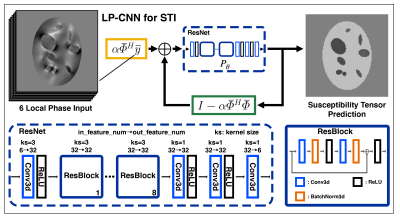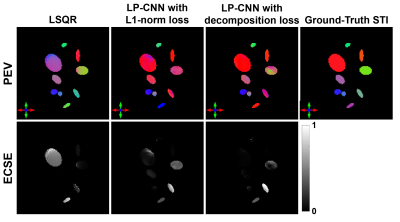Kuo-Wei Lai1,2, Jeremias Sulam1, Manisha Aggarwal3, Peter van Zijl2,3, and Xu Li2,3
1Department of Biomedical Engineering, Johns Hopkins University, Baltimore, MD, United States, 2F.M. Kirby Research Center for Functional Brain Imaging, Kennedy Krieger Institute, Baltimore, MD, United States, 3Department of Radiology and Radiological Sciences, Johns Hopkins University, Baltimore, MD, United States
1Department of Biomedical Engineering, Johns Hopkins University, Baltimore, MD, United States, 2F.M. Kirby Research Center for Functional Brain Imaging, Kennedy Krieger Institute, Baltimore, MD, United States, 3Department of Radiology and Radiological Sciences, Johns Hopkins University, Baltimore, MD, United States
We developed a physics-informed Learned Proximal Convolutional Neural Network (LP-CNN) with specialized loss function for Susceptibility Tensor Imaging (STI) reconstruction and demonstrated its feasibility with synthetic phantoms.

Figure 1: Network architecture of LP-CNN. In the ResNet, there are 8 stacks of residual blocks. Each residual block contains 2 convolutional layers, 2 batch normalization layers, and 2 ReLU layers with 1 skip connection for residual learning. The forward pass of LP-CNN for STI contains 3 iterations.

Figure 3: Principal eigenvector (PEV) maps of the reconstructed susceptibility tensors in anisotropic regions using different methods and the associated ECSE maps. The color represents the PEV direction, and the ECSE maps show the angle difference between the reconstructed PEV and the ground-truth PEV.